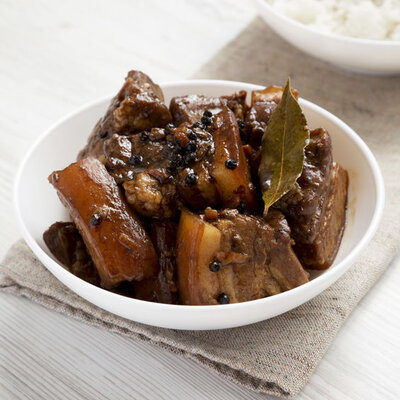
Humba
What is Humba?
Humba is a Filipino pork-based dish that contains banana blossoms, salted black beans, pineapple juice, soy sauce, and brown sugar. This food should not be mistaken for adobo, as there is a difference in its preparation. For adobo, you mix all the ingredients and allow them to simmer.
- On the other hand, people make humba using the braising technique and this dish has a slightly sweet taste because of the presence of brown sugar.
- Additionally, humba is commonly served with rice and vegetables.
The top 10 most popular dishes in the Philippines are:
- Chicken Adobo
- Balut
- Kare Kare
- Kinilaw
- Sinigang
- Lechon
- Tapsilog
- Halo-halo
- Buko Pie
- Arroz Caldo
Origin of humba
This meal was made famous on the Visayan Islands in the central Philippines. Some accounts say that the dish originated from the Visayas. Others say that Fujian Chinese settlers were the masterminds behind this delicacy and that the dish originates from Chinese red braised pork belly. Nonetheless, it is common for people to cook this food on special occasions like birthdays and public gatherings. However, it can also be enjoyed as a daily meal.
Nutrition
In a 181 g serving of humba, there are:

Pork belly is a core ingredient in this food. Some health benefits of this dish, by virtue of its pork content, are:
- It is rich in potassium and has low sodium content. This combination makes it great for heart health.
- This meat serves as a protein source, which provides amino acids needed for body growth and development.
- It contains vitamins that can assist in the production of red blood cells.
- This food contains niacin and zinc, which are essential for proper body metabolism and a functioning immune system.
- It can help maintain muscle mass and improve a person’s exercise rate.
However, there is a precaution to keep in mind while making humba. Raw or poorly cooked pork belly can be harmful to humans. This meat can contain organisms like parasitic roundworms and pork tapeworm. These organisms might cause mild feelings of nausea, diarrhea, and stomach pain. Ensure that your pork does not have these parasites and is always properly cooked.
Commercial production
Filipino families commonly cook humba on a large scale during special occasions and gatherings. In 2019, the global pork meat market was valued at $236,112.7 million. This value was expected to hit $257,874.5 million by 2027 with a Compound Annual Growth Rate of 3.9% between 2021 and 2027. In 2020, China produced the largest amount of pork globally, with a value of 34 million metric tons. The value of the global pork production market was 94.33 million metric tons.
Application
Improve your results while making this food by following the tips below:
- Use brown sugar, not white sugar, for this dish. Brown sugar has a less intensely sweet taste and also contains molasses, which improves the dish’s texture.
- Don’t marinate the pork for longer than 8 hours because of the acidity of the pineapple juice.
- Keep the heat low to allow slow cooking, so that the connective tissues of the meat can soften.
Humba recipes
Several top-rated recipes highlighting the versatility, richness, and depth of this dish include:
- Pork Humba
- Slow-Cooked Crackling Pork
- Crispy Golden Pork Belly
- Rolled Pork Belly with Herby Apricot & Honey Stuffing
- Chicken Humba
FDA regulation
The Food and Drug Administration has guidelines for using ionizing radiation to control Trichinella spiralis in pork carcasses or fresh, non-heat-processed cuts of pork carcasses. The FDA recommends that ground pork be stored for a maximum of 1-2 days and 3-4 months in the refrigerator and freezer, respectively. They also recommend that you cook ground pork to at least 160°F to prevent foodborne illnesses.
References
Merano, Vanjo. “Humba Recipe.” Panlasang Pinoy, Panlasang Pinoy, 16 Dec. 2020, panlasangpinoy.com/filipino-food-pork-humba-recipe/.
“Pork Nutrition Is Key to a Healthy, Balanced Diet.” www.pork.org, Pork Checkoff, www.pork.org/cooking/pork-nutrition/.
“CFR – Code of Federal Regulations Title 21.” accessdata.fda.gov, US Food & Drug Administration, 1 Apr. 2019, www.accessdata.fda.gov/scripts/cdrh/cfdocs/cfcfr/CFRSearch.cfm?fr=179.26.
